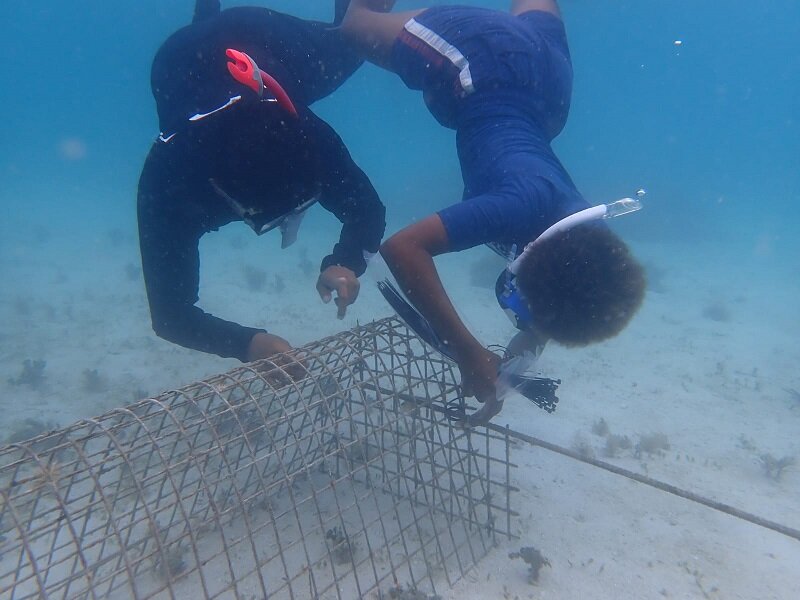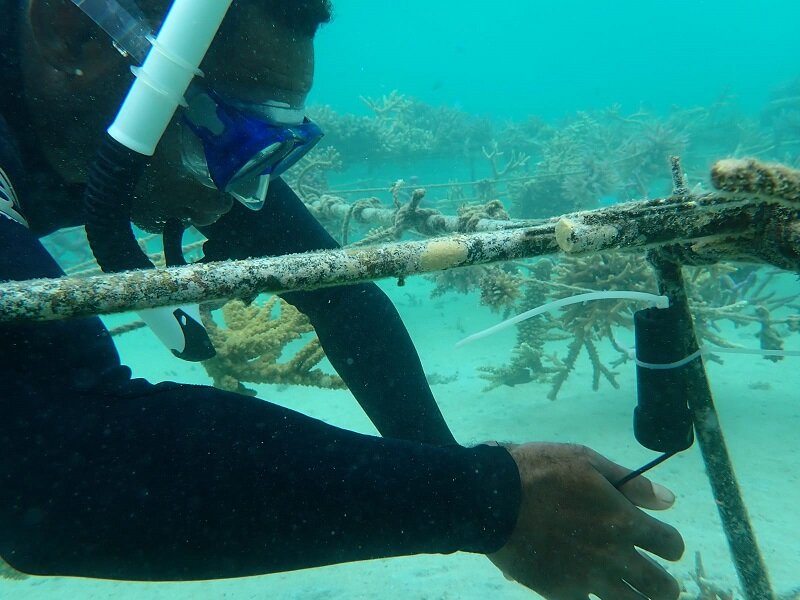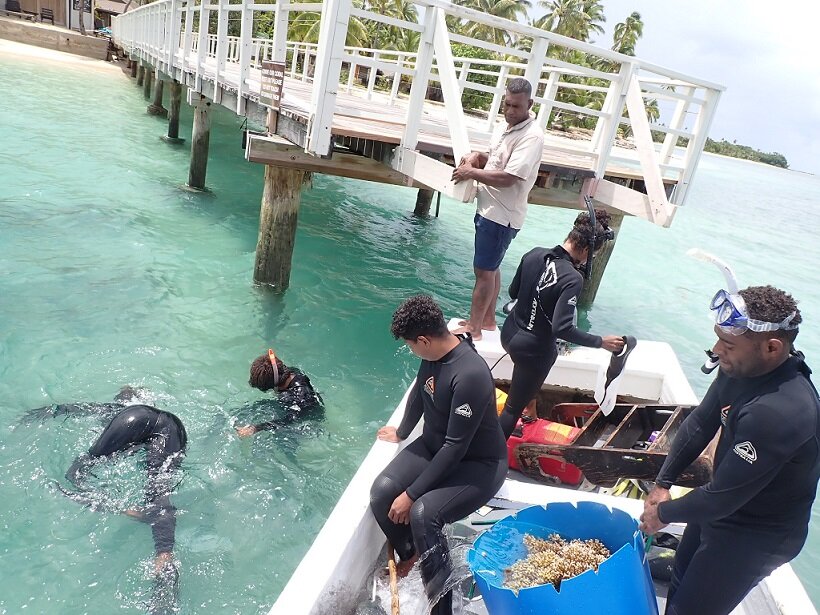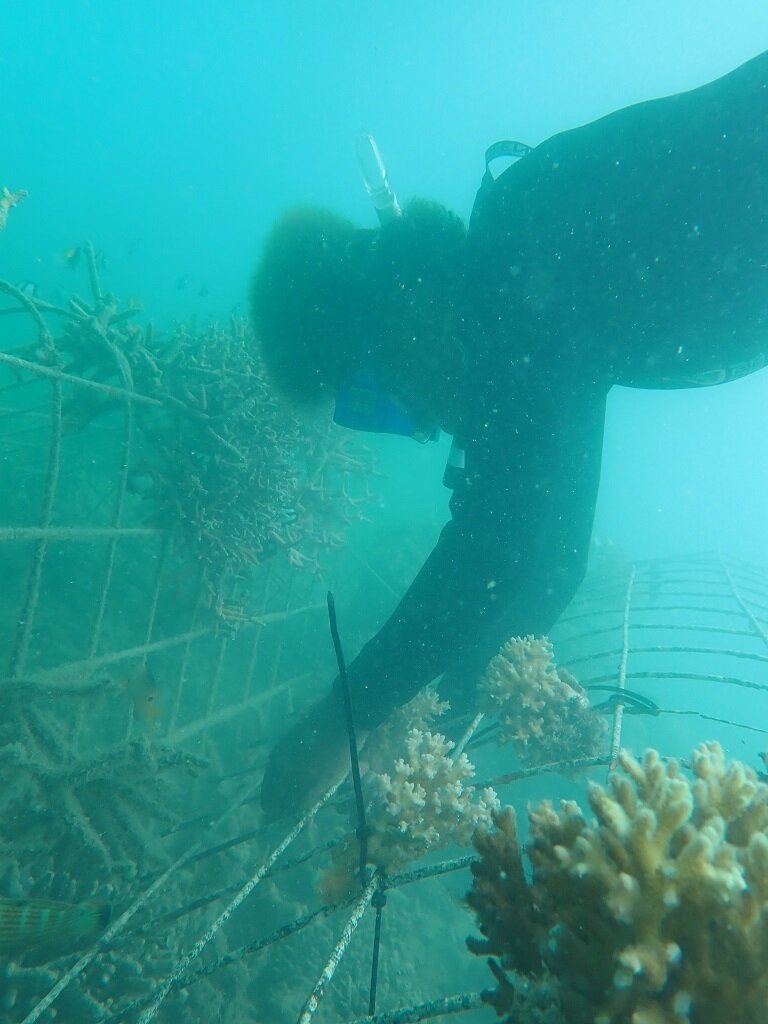By Austin Bowden-Kerby, Phd. | Lead Marine Scientist: Corals for Conservation
Yet another ocean heat wave approaches Fiji from the West. The deep ocean is already at 29C (84F) and some nearshore areas are at 31C (88F) ins. Fiji has gone from bleaching watch to bleaching warning, with a few colonies already showing stress, and the more major coral bleaching is predicted to hit by March, peaking in April and possibly continuing into May. With the hotter than normal ocean temperature, the formation of cyclones is more likely as well. We spent the month of December preparing the coral sites for the approaching bleaching and possible cyclones. In January a cyclone brushed past us and cooled the waters down some, but it did little damage to the reefs and nurseries, rather helped by removing some pesky overgrowing seaweeds that the fish don't like to eat!
Our Indigenous Corals for Conservation's team, (six women and one man), headed by our two skilled marine scientists, Sarah and Merekeleni, and including five local university marine studies graduates, worked intensely with C4C project scientist Austin, to prepare the 'super coral' nurseries filled with bleaching resistant corals, to prepare the nurseries for possible storm generated currents and waves. Concerned that currents would exert excessive drag force on the corals suspended on ropes, we removed the largest colonies from the coral genebank nurseries. Still attached to their ropes, we planting them to the reef using the pegged-rope method, as whole colonies onto barren reef rock. Each genotype was also trimmed and replanted as smaller fragments back to the nursery, so that the gene bank would retain all the coral diversity we have collected over the past three years. The corals in the nurseries had all originally been collected from the nearshore hot pocket reefs, where the water can reach 34C in the summer, and these hot pocket corals were then moved into gene bank nurseries, located on the cooler middle barrier reef, where the water can get to 31C in the summer. So as long as the temperature remains below 34C (93F), they should all be fine and will not likely bleach in even a severe mass bleaching, even if the corals around them on the reef bleach.
We planted some of the ropes filled with corals from the nursery into a new experimental set up, planting them among thriving corals at Nuku Point reef, one of the most amazing reefs remaining, with high coral cover and especially thick in plate forming corals, a species that is among the first to die out from climate change. But why would we plant more corals to where corals are already so abundant? This was done to test the hypothesis that heat adapted super corals can spread their resistance to their neighbors. The background to this is that it is the microalgae in the corals, which they rely on for photosynthesis and their food, that are so impacted by the heat, and so it is actually super algae that are responsible for bleaching resistance in most corals! So in the coming months, we will likely see a big contrast in bleaching susceptability between the extremely heat resistant coral patches that we have created and the less heat resistant corals naturally found on the reef, with the less resistant native corals losing their brown algae and turning white. But if they do survive, our hope is that they will pick up some of the algae that is known to leak out of the neighbors, and with super algae in the neighborhood, when they re-color, will they pick up the super algae and thus become bleaching resistant and adapted for the next rounds of bleaching in the summers to come, and as the planet continues to warm?
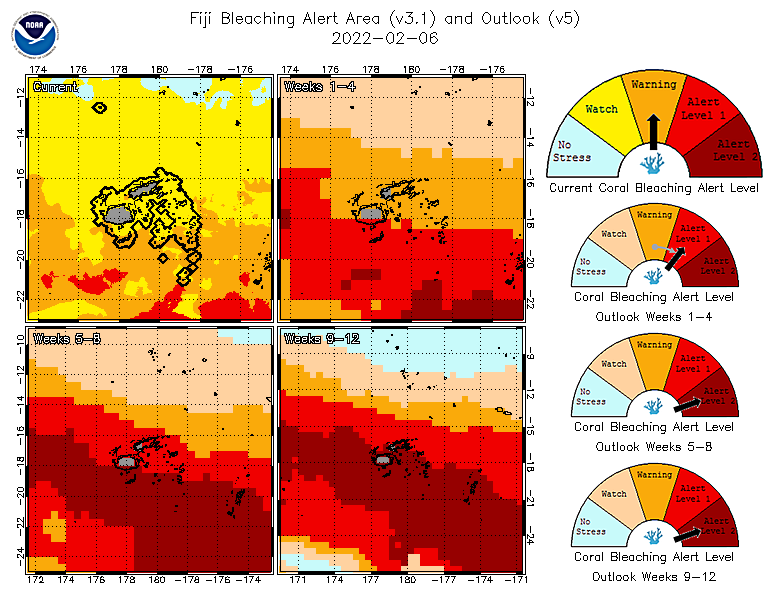
Two film makers came from Los Angeles to record the work, so this drama is now on film, and so this drama will in time be available for all to see via the internet, so that the lessons we learn can be incorporated into the work of other restoration projects, short-cutting the time it takes to publish data.
In January, despite being triple vaccinated, I came down with Covid-19, which I contracted as the result of helping send off our film makers, while getting them their pre-flight test at the local hospital, everyone waiting for pre-flight tests were together with others who were suspected of having the virus, also waiting for their test! Alas, I was swept up by the wave of Omicron virus which is traveling nearly as fast as a tsunami across Fiji. The filmmakers also came down with COVID after returning home. What started out as a mild case, took a turn for the worse, but I am grateful to have survived, so that I may continue to devote my life to helping corals survive!
Loud blasts were heard in our coral reef sites from the recent massive volcanic explosion in Tonga. The vocanic eruption was over 800km (500 miles) away, nevertheless it sounded like a war for 30 minutes, and within two hours a tsunami reached Fiji's shores- our sites were fine, as we are sheltered behind the outer barrier reefs, which absorbed the waves. Some Fijian villages on islands closer to Tonga were impacted and some homes were destroyed, but mostly it was a only a foot or two of seawater washing through the coastal villages, invading some homes. The resulting ash cloud arrived over the coming days, and our internet was very glitchy. Whether related to the volcano or not, rain started here, about a week after the explosion and had been nearly incessant since, with dry breaks lasting only a few hours at a time. Yesterday major flooding occurred and several towns were under water, with people forced to evacuate their homes. The power also failed yesterday, and just came back this morning at 4am. Nearby Australia and New Zealand are also experiencing major flooding, so I am wondering if the SO2 from the volcano has super-charged the La Nina weather patterns? Or did so much water vapor get injected into the atmosphere that it all has to come out as rain? Will these thick clouds and rain now also cause the bleaching to be less severe? Stay tuned!
In closing, I want to pay a bit of attention to Tuvalu, the tiny nation to the north of Fiji, where we have established five coral nurseries in the past, but where we can not get back to, due to the total lack of flights due to the pandemic. The youth we helped train in 2018-19, formed a registered NGO, "Fuligafou" (new beginnings), and they are continuing with the coral work and environmental work, through a grant from the Australian Embassy- with a plan to expand the work now to Nui Atoll! Tuvalu remains one of the few places on earth without a single case of the virus. Tuvalu is also one of the nations expected to disappear due to climate change and sea level rise, which is now coming up at 5mm per year- an inch every 5 years! COP26, the big intergovernmental meeting in Scotland late last year was a big failure for the most part, but the foreign minister of Tuvalu sent a message to the conference, and I wanted to share a photo of his presentation with you. What better way to show that sea level rise is very real. Tuvalu and all nations have a right to survive into the future, and coral reefs also have that right. Coral reefs have formed entire island nations, and the health and growth of corals are needed to keep them above the waves. However, nearly half of those attending COP26 represented big oil interests, and so it is not surprising that many governments continue to subsidize the fossil fuel industry. Therefore, we need every individual to exercise their vote and lifestyle if possible to transform the global economic system, from a carbon based economy to a carbon negative one, filled with trees and expanding forests and corals and thriving coral reefs. Otherwise, with business as usual, the coral reefs will soon all be gone- within a short 30-50 years, and the oceans may even die, and that would stop the production of up to 70% of the planet's oxygen, jeopardizing humanity. Pacific Island nations, and the coral reefs we depend on are positioned on the very frontline of what must become a war on climate change! We at C4C are focused on developing war plans and battle strategies, and one day we hope to have the troops, generals, weapons, and ammunition required to win this war. But we also must starve the enemy of its fuel- which is carbon pollution!
Thanks for giving us the resources to continue this struggle!
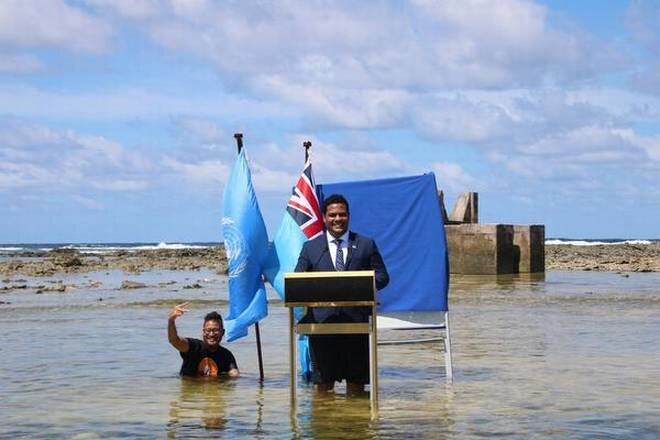
Project reports on GlobalGiving are posted directly to globalgiving.org by Project Leaders as they are completed, generally every 3-4 months. To protect the integrity of these documents, GlobalGiving does not alter them; therefore you may find some language or formatting issues.
If you donate to this project or have donated to this project, you can receive an email when this project posts a report. You can also subscribe for reports without donating.
Support this important cause by creating a personalized fundraising page.
Start a Fundraiser